Overview
The article underscores the critical reclamation procedures required for the effective restoration of drilling sites. It asserts that successful reclamation hinges on:
- Thorough site assessments
- Strict adherence to regulatory compliance
- Community engagement
- The integration of advanced technologies
These elements collectively enhance ecological recovery and sustainability in land restoration efforts, addressing the complexities faced by stakeholders in the energy sector.
Introduction
In the realm of environmental restoration, the complexities of reclamation projects necessitate a multifaceted approach that integrates advanced technology, community engagement, and strict adherence to regulatory standards. As industries evolve and the demand for sustainable practices escalates, organizations like Harbinger Land emerge as crucial players, offering specialized land acquisition services designed to support reclamation initiatives. By leveraging cutting-edge GIS mapping and implementing effective waste management strategies, the reclamation landscape is undergoing significant transformation.
This article explores the essential components of successful reclamation, beginning with the importance of thorough site assessments and innovative soil remediation techniques. It also underscores the vital role of local communities in fostering collaboration. How can we enhance project outcomes and contribute to a more sustainable future for our environment? By examining case studies and expert insights, we reveal that a commitment to continuous improvement is key.
As we delve deeper, consider the challenges faced in land acquisition—legal and regulatory hurdles that can impede progress. Yet, with the right expertise and resources, effective solutions are within reach. Organizations like Harbinger Land stand ready to guide you through these complexities, ensuring that reclamation efforts are not only compliant but also environmentally beneficial. Together, we can pave the way for a sustainable future.
Harbinger Land: Comprehensive Land Acquisition Services for Reclamation Projects
Harbinger Land excels in delivering tailored land acquisition services specifically designed for reclamation procedures for drilling sites. Their extensive offerings include:
- Site and right-of-way acquisition
- Thorough title research
- Advanced GIS mapping
By leveraging cutting-edge technology—such as AI-powered title research software and highly integrated GIS modeling services—Harbinger Land significantly enhances the efficiency and accuracy of land acquisition processes. This technological edge ensures that the reclamation procedures for drilling sites progress smoothly and adhere to timelines, ultimately saving clients both time and money. With a seasoned team skilled in navigating the complexities of land services, Harbinger Land establishes itself as an indispensable partner for energy and infrastructure stakeholders committed to effective reclamation procedures for drilling sites. The increasing demand for environmental impact assessments further highlights the significance of their services in the dynamic landscape of land consulting.
For example, the Chiba Prefecture case study illustrates the financial ramifications of land acquisition, showcasing how Harbinger Land's expertise can effectively mitigate costs, evidenced by a substantial payment of ¥220,000 for an Akiya purchase. Additionally, insights from the 'Solar Infrastructure Asset Management' case study underscore vital strategies for managing solar infrastructure assets, providing valuable lessons for land acquisition in reclamation efforts.
As an experienced realtor pointed out, 'The main reason to hire a surveyor is to identify the precise location of boundaries,' which underscores the necessity of accurate land services in these endeavors. Furthermore, Harbinger Land's document imaging solutions streamline title research and leasing processes by employing imaging agents at courthouses and obtaining documents through records requests. This ensures that title agents can efficiently execute their tasks, which is crucial for the success of energy and infrastructure initiatives.
Understand Regulatory Compliance in Reclamation Procedures
Regulatory compliance stands as a cornerstone of successful restoration efforts, demanding a comprehensive understanding of local, state, and federal regulations that govern land use and environmental protection. Prior to 1975, the restoration of mined land was not mandated, highlighting the evolution of regulatory frameworks that now shape these initiatives. Compliance with laws such as the Clean Water Act and the National Environmental Policy Act (NEPA) is imperative, as non-compliance can result in substantial setbacks.
Engaging with regulatory bodies early in the planning process not only facilitates the identification of necessary permits but also streamlines compliance efforts, significantly enhancing the likelihood of success. For instance, the Florida Industrial and Phosphate Research Institute (FIPR), established in 1978, has become a leading research organization in phosphate-related restoration, exemplifying the benefits of aligning projects with regulatory standards.
Furthermore, ecological scientists often engage in outreach education and grant writing initiatives, fostering community support and bolstering compliance efforts. The recent updates to ecological regulations for land restoration in 2025 underscore the importance of staying informed about compliance obligations.
As Mohandas K. Gandhi aptly noted, "Earth provides enough to satisfy every man's need, but not every man's greed," reminding us of our ethical responsibility to care for our environment. By prioritizing regulatory adherence, restoration projects can achieve superior outcomes, ultimately advancing sustainable land use and environmental protection.
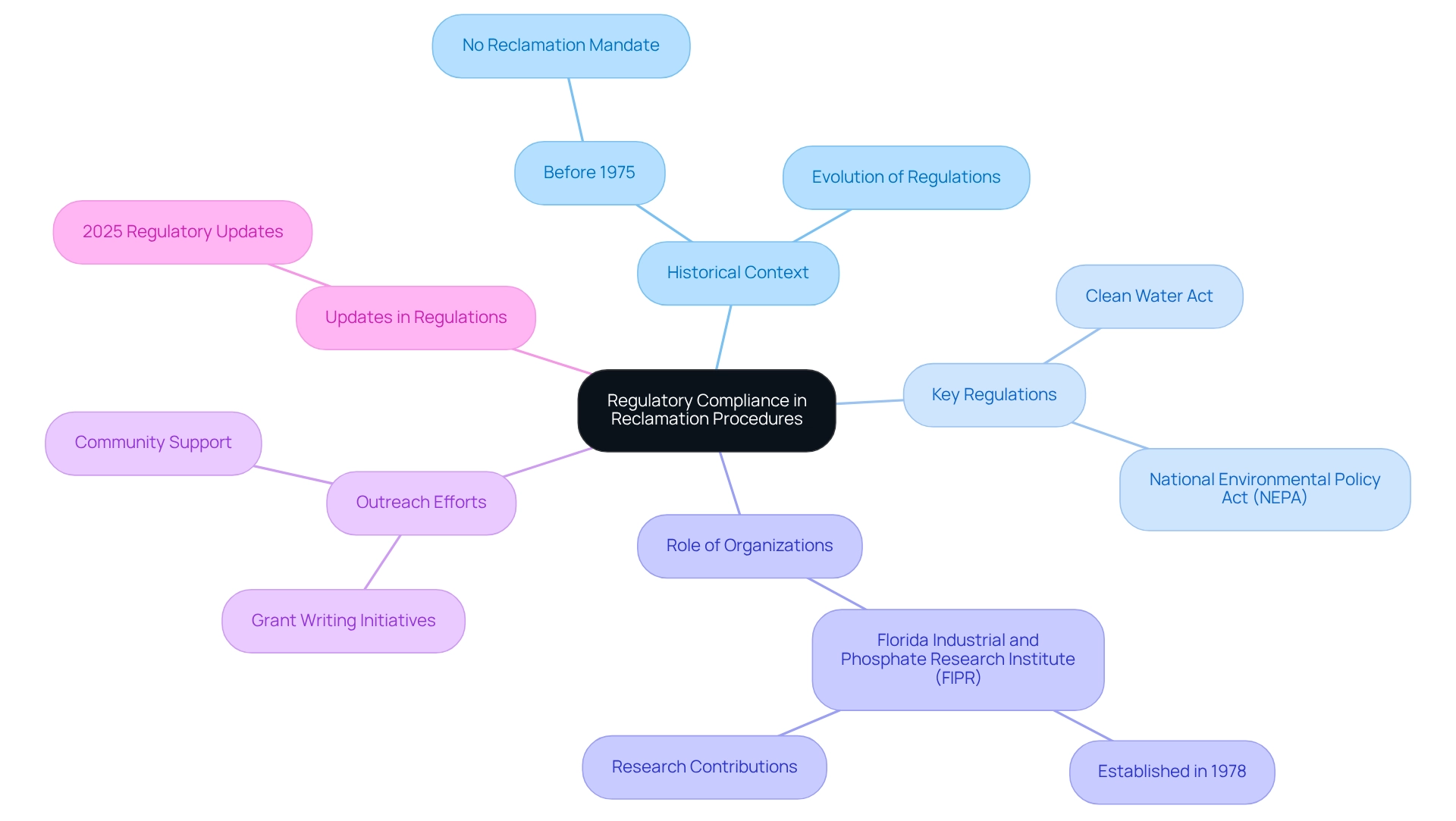
Conduct Thorough Site Assessment and Planning
A comprehensive site assessment is crucial for successful restoration, necessitating an in-depth evaluation of the land's physical, chemical, and biological characteristics. This process includes:
- Soil testing
- Hydrological studies
- Ecological surveys
These evaluations together provide a clear understanding of existing conditions and potential challenges. Effective planning, informed by these evaluations, enables the development of tailored restoration strategies that directly address specific site needs. Such customized methods are essential for ensuring that restoration initiatives are both efficient and sustainable, ultimately enhancing the success rates of recovery projects.
Research indicates that focused management approaches, which consider the ecological effects of various restoration methods, greatly improve outcomes. For instance, the degradation rate functions as a dependent variable in the regression model for assessing recovery impacts, underscoring the importance of localized strategies. Furthermore, the case study titled "Regional Variability in Restoration Contributions" illustrates how different restoration types exhibit variable contributions to wetland degradation across regions.
As the field advances, the integration of cutting-edge technologies and methods will further refine site evaluation procedures, paving the way for more effective restoration initiatives. As Shidong Wang notes, "Mine restoration land quality assessment is a thorough and systematic endeavor, encompassing many fields, such as agronomy, remote sensing, GIS, and mathematics." This multidisciplinary approach is vital for effective site assessment and planning.
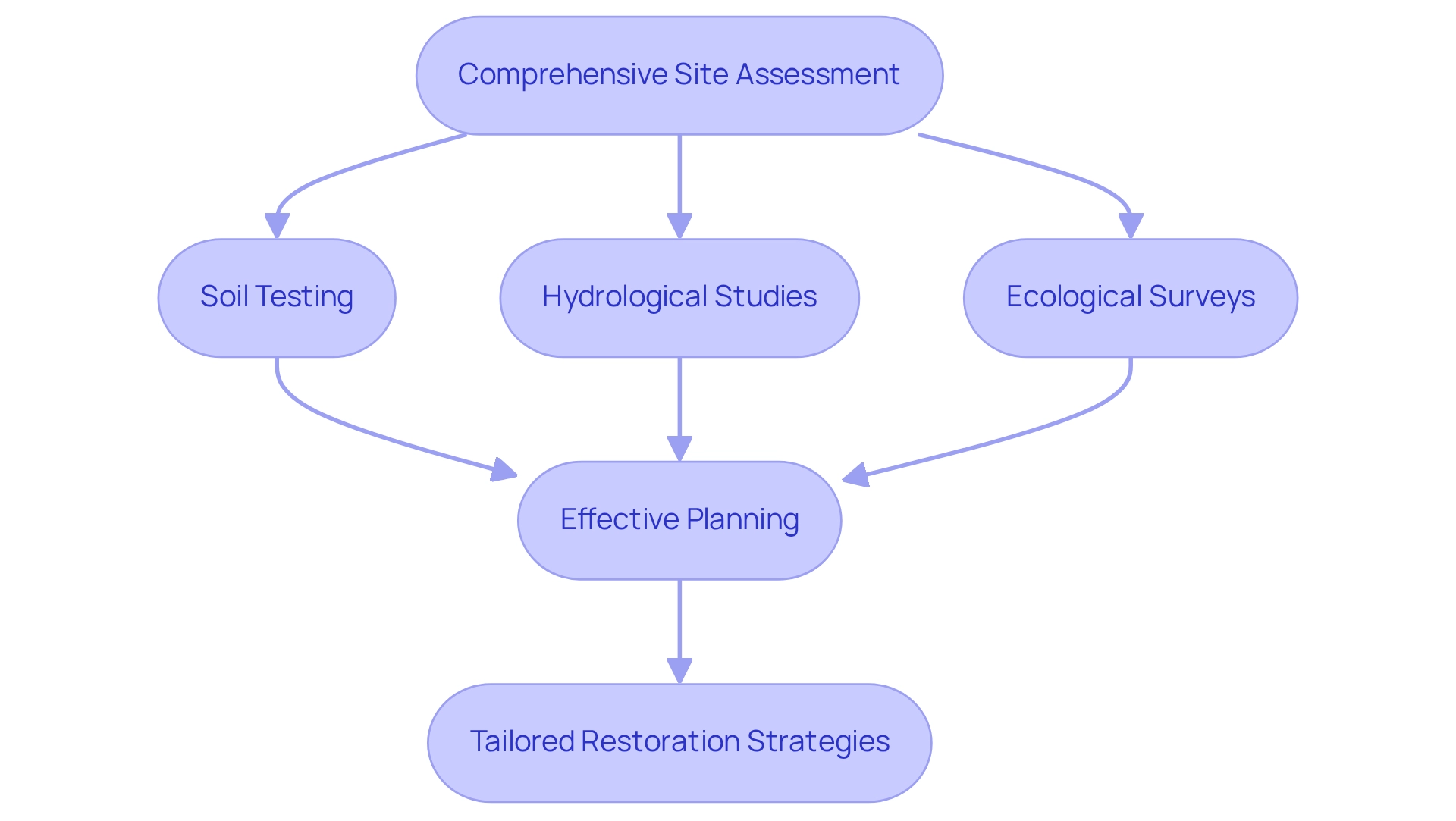
Implement Effective Waste Management Strategies
Efficient waste management approaches are crucial for mitigating the ecological impact of restoration activities. This process begins with the identification of waste streams, followed by efforts to reduce waste generation, and culminates in the proper disposal or recycling of materials. Techniques such as waste segregation, composting, and the utilization of biodegradable materials can significantly enhance sustainability.
For instance, the recycling rates for corrugated boxes reach an impressive 97%, while furniture recycling lags at a mere 0.3%. This stark contrast underscores the urgent need for targeted recycling initiatives. Furthermore, rubber, leather, and textiles account for over 11 percent of landfilled municipal solid waste (MSW), highlighting the importance of addressing these materials within recovery efforts.
In 2018, 2.7 million tons of selected consumer electronics were generated, constituting less than 1 percent of total MSW generation, which further illustrates the complexities faced in effective waste management. Adhering to optimal management techniques not only fosters environmental sustainability but also leads to cost savings and improved outcomes.
As one expert aptly stated, 'Change starts when we decide that waste has no place in our lives,' emphasizing the necessity for innovative waste management strategies. By adopting these approaches, restoration projects can realize both ecological and economic advantages, paving the way for a more sustainable future.
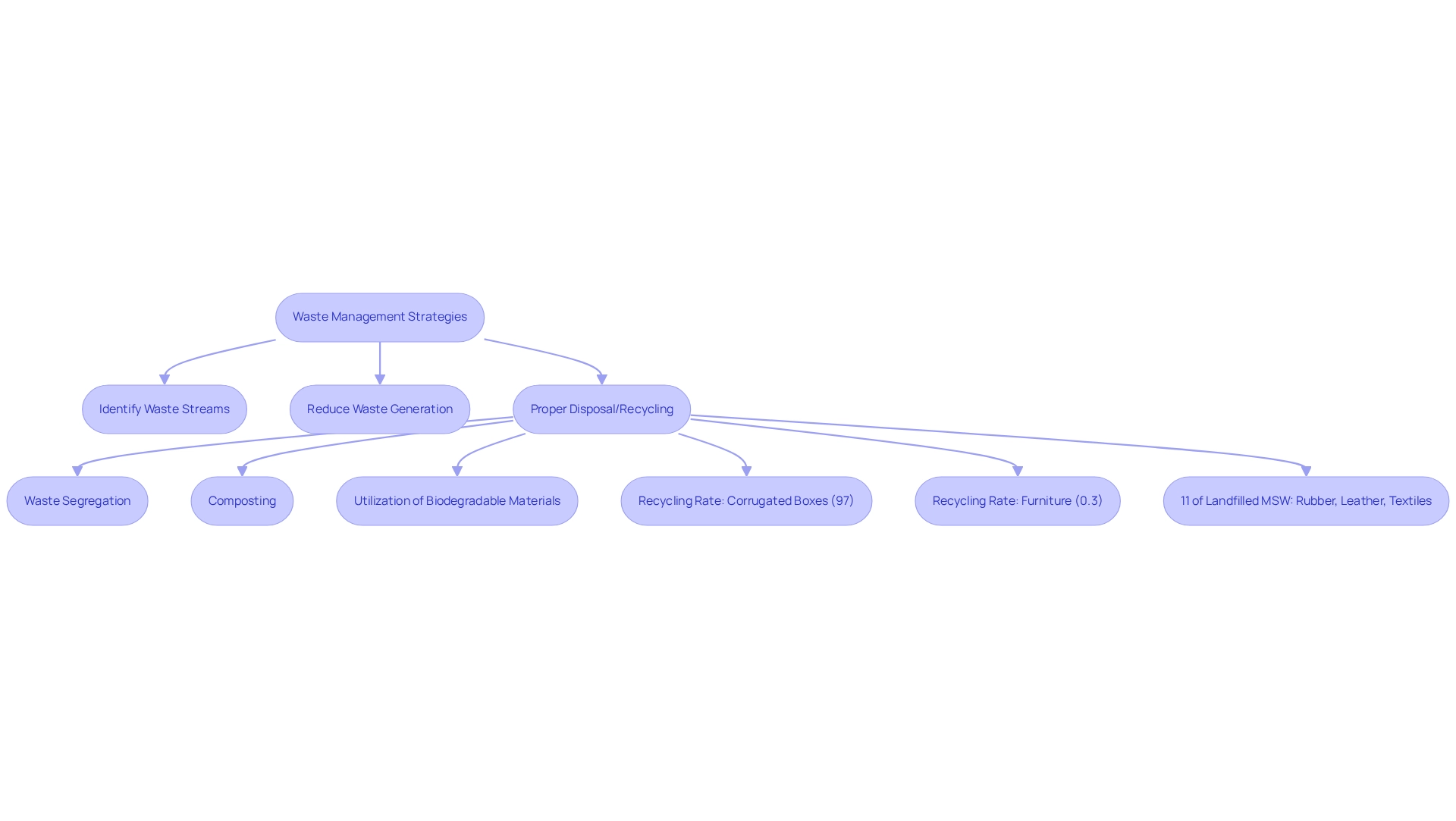
Utilize Soil Remediation Techniques for Ecological Restoration
Soil remediation techniques are crucial in ecological restoration during reclamation procedures for drilling sites. Methods such as bioremediation and phytoremediation effectively remove contaminants and revitalize soil health. For example, phytoremediation strategies—including phytodegradation, phytoextraction, and phytostabilization—are recognized for their ability to detoxify environmental toxins, ensuring sustainability for future generations. A study highlighted that lead (Pb) accumulation in the roots of K. paniculata reached an impressive 81.31% to 86.69%, underscoring the effectiveness of these plants in pollutant removal.
The systematic review of various soil remediation techniques reveals that the best results for oil-contaminated soils are obtained through reclamation procedures for drilling sites that integrate multiple strategies. This method enhances efficiency, reduces cleanup time, and lessens ecological impact, making it a cost-effective solution. The biological method stands out as an eco-friendly option, while traditional chemical and physical methods often incur higher costs and adverse environmental effects.
Successful bioremediation and phytoremediation projects, as illustrated in the July 2023 study on various phytoremediation approaches, underscore the effectiveness of reclamation procedures for drilling sites in achieving significant improvements in soil health. These projects contribute to the restoration of ecosystems and the reestablishment of native vegetation and wildlife. As the field evolves, expert opinions increasingly support the incorporation of innovative techniques, such as the use of nanomaterials in bioremediation systems, to enhance pollutant removal efficiency. An expert noted, "The incorporation of nanomaterials into bioremediation systems has emerged as a promising approach to enhance pollutant removal efficiency." By employing these advanced strategies, restoration initiatives can achieve more sustainable and successful outcomes, ultimately benefiting both the environment and local communities.
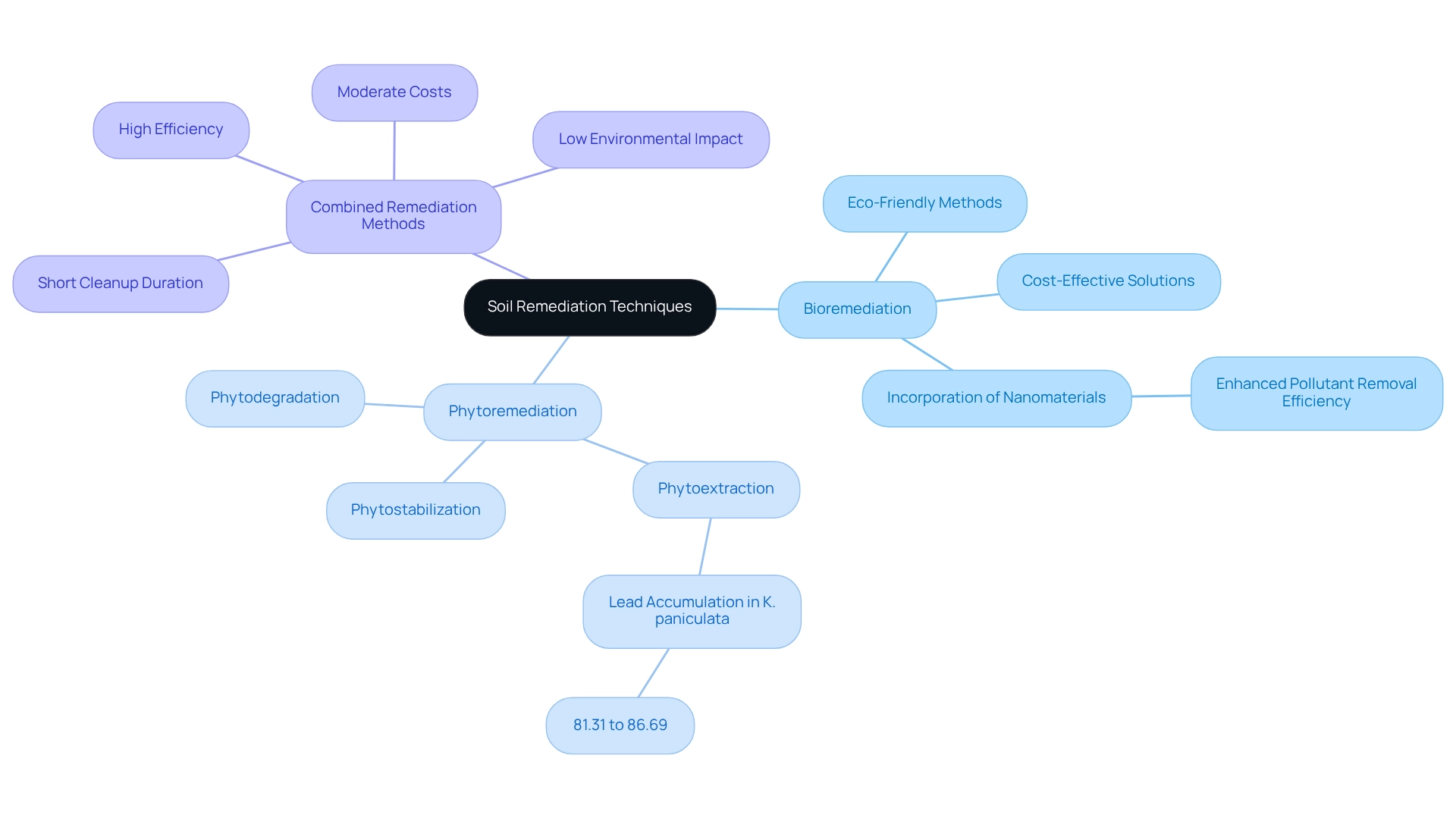
Focus on Vegetation Re-establishment for Habitat Recovery
Vegetation re-establishment stands as a cornerstone of habitat recovery in reclaimed areas. Prioritizing native plant species that thrive in local conditions not only boosts biodiversity but also enhances ecosystem resilience. Effective techniques, such as direct seeding, planting seedlings, and employing erosion control blankets, promote successful vegetation establishment. Monitoring growth and adapting management practices are crucial to ensuring that restored habitats achieve their ecological objectives. Notably, research indicates that the presence of legumes in restoration plots correlates with decreased soil fungal pathogen abundance, highlighting the importance of diverse plant communities.
Successful restoration initiatives demonstrate that selecting suitable native species can significantly enhance ecological quality and overall recovery results. This underscores the importance of community-led actions in habitat restoration. Furthermore, landcover classification maps, created using random forest classification, exhibit an overall accuracy of 99% and Kappa values exceeding 0.98, underscoring the reliability of mapping methods in these projects. Insights from the case study titled 'Interactions Between Soil Bacteria and Plant Diversity' reveal that increased plant diversity is associated with stronger interactions between soil cellulolytic and non-cellulolytic bacteria, which are essential for nutrient cycling and soil health.
As Timothy J. Robinson, a Professor of Statistics at the University of Wyoming, notes, the applications of statistics to ecology and the environment are vital for understanding these complex interactions. Overall, community-driven restoration initiatives have been shown to enhance ecological quality and recovery results, emphasizing the significance of cooperative methods in habitat restoration.
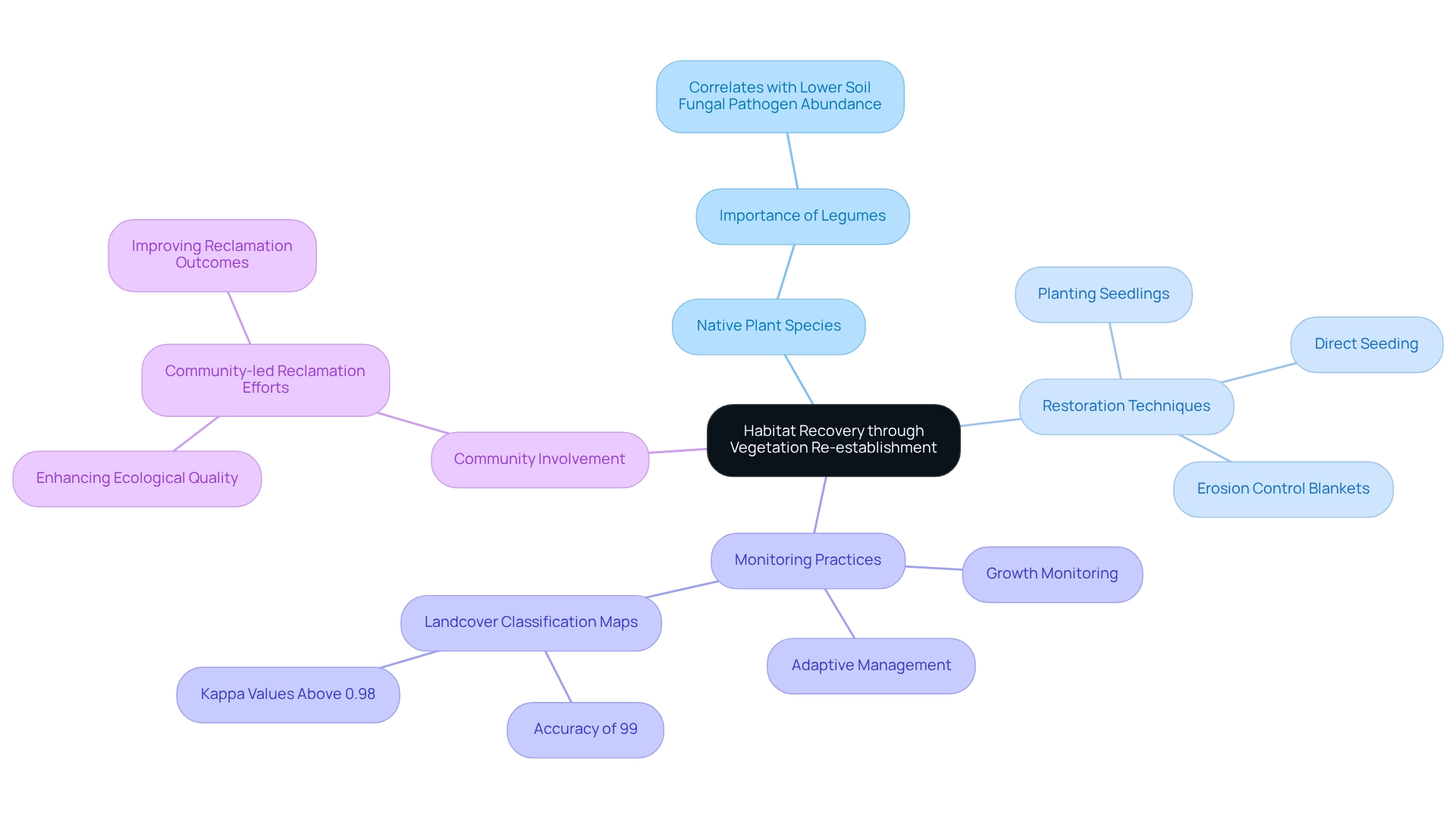
Establish Monitoring and Evaluation Practices for Reclamation Success
Implementing strong monitoring and assessment practices is crucial for measuring the success of restoration efforts. This process begins with defining clear performance indicators, which serve as benchmarks for assessing vegetation growth, soil health, and wildlife presence. Consistent data gathering is essential; research shows that soil characteristics and environmental factors at restoration sites frequently fall short of standard ranges. By utilizing advanced technologies like remote sensing and GIS, teams can significantly improve their monitoring capabilities. These tools facilitate the long-term tracking of vegetation changes, as demonstrated in case studies that highlight the importance of ongoing monitoring in mining areas to inform restoration practices.
Moreover, adaptive management approaches, guided by frequent assessments, enable teams to make data-driven choices that enhance restoration strategies over time. Recent advancements in remote sensing and GIS technologies in 2025 have proven successful in monitoring restoration projects, leading to improved accuracy in assessing ecosystem recovery and degradation levels. This underscores the importance of incorporating these techniques into standard practices for optimal recovery results. As highlighted by Rongrong Ma, expert views underscore the essential function of performance indicators in attaining effective restoration, reinforcing the need for continuous assessment.
Additionally, recent observations indicate that plants have stabilized the soil and improved ecosystem health, showcasing the positive impacts of effective monitoring practices. What challenges do you face in your restoration efforts? How can these monitoring practices transform your approach? The evidence is clear: strong monitoring is not just beneficial; it is essential for successful restoration.
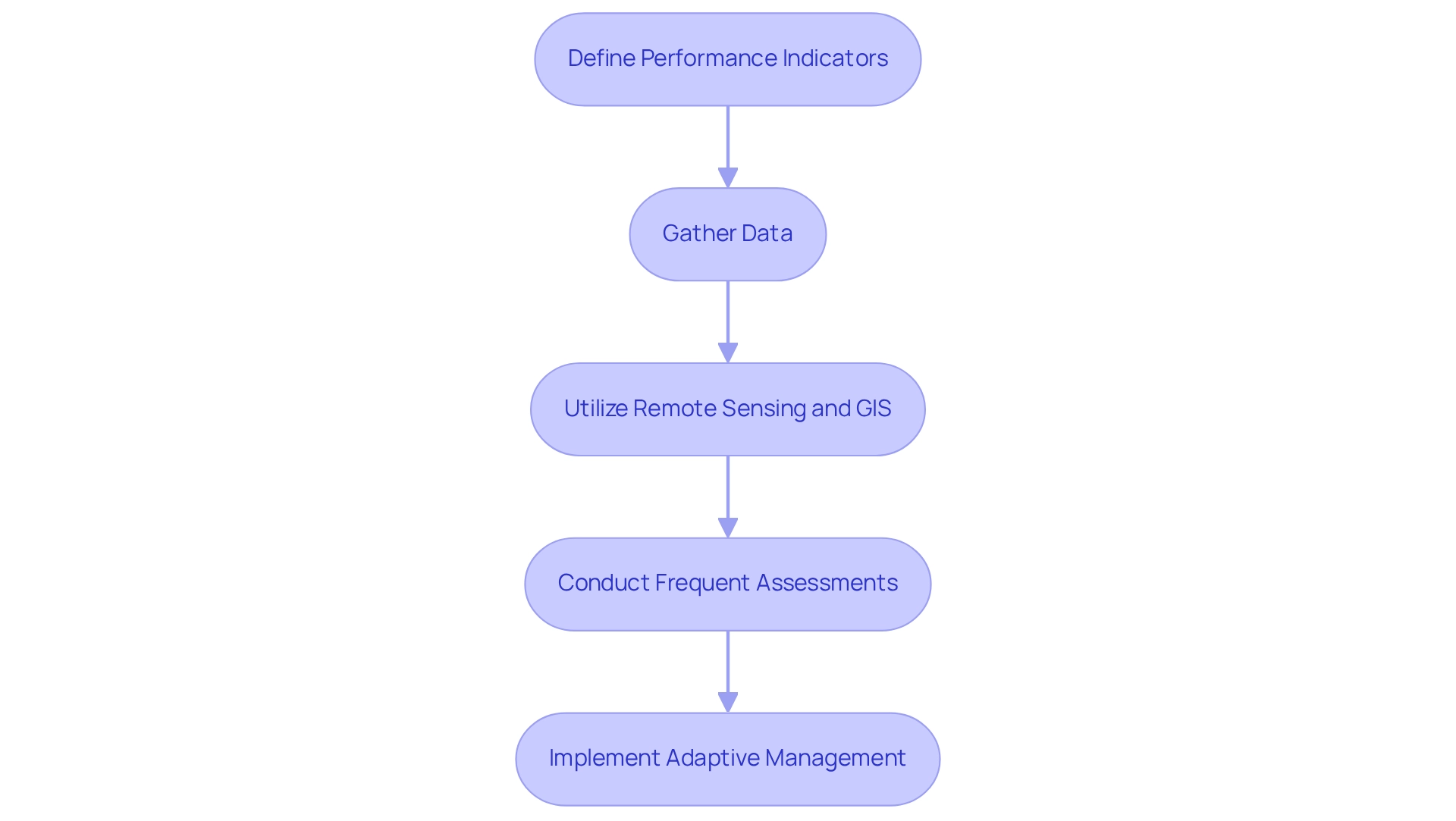
Engage with Local Communities for Support and Collaboration
Involving local communities is essential for gaining backing and promoting cooperation in restoration initiatives. Effective strategies include:
- Hosting public meetings
- Conducting informational sessions
- Forming partnerships with local organizations
By actively engaging community members in both planning and execution, teams can effectively tackle local issues and incorporate traditional ecological knowledge, greatly improving the success of restoration efforts. Trust-building and open communication are essential components of effective community engagement.
The Uttar Pradesh Sodic Lands Reclamation Project illustrates the significance of beneficiary involvement and institutional mechanisms for sustainable land management. Data suggest that initiatives with robust community backing experience greater success rates, underscoring the importance of local involvement in ecological restoration efforts. Successful collaborations with local organizations not only enhance results but also aid in long-term community resilience and environmental stewardship.
As C. S. Singhal observed, 'Community involvement is essential for the success of land restoration initiatives.' To initiate community engagement efforts, consider implementing:
- Surveys
- Focus groups
- Workshops
to gather input and foster collaboration with local stakeholders.
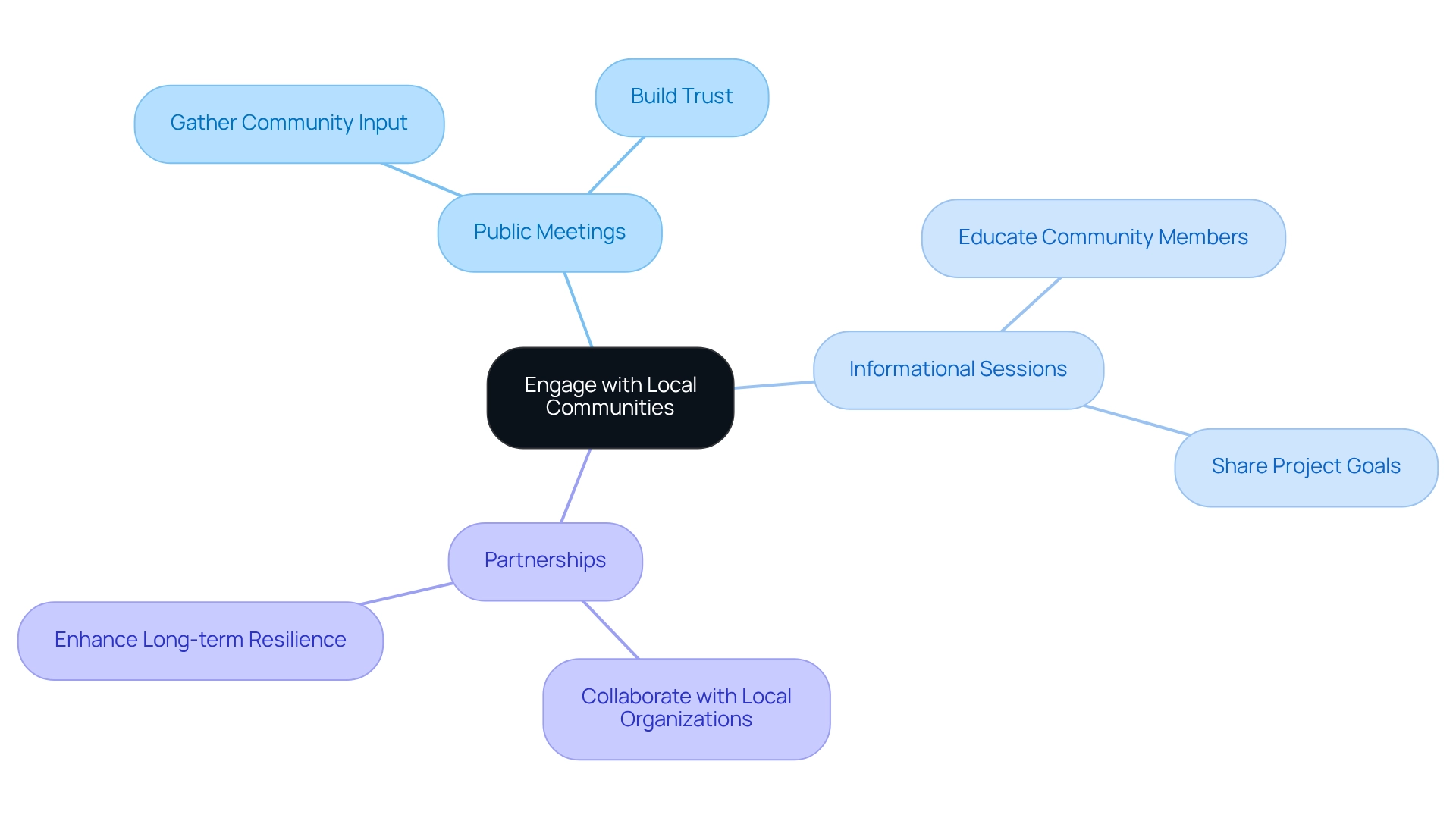
Leverage Technology for Enhanced Reclamation Processes
The incorporation of advanced technology is revolutionizing recovery methods in oil ventures. Drones facilitate aerial surveys, delivering high-resolution imagery that enhances site assessments and monitoring. Geographic Information Systems (GIS) are pivotal in mapping and analyzing land use, enabling project teams to visualize data effectively and make informed decisions.
As highlighted in a recent case study, maps serve as powerful tools for storytelling, illustrating the complexities of land use and environmental impacts—an essential aspect for effective communication in restoration efforts. Furthermore, artificial intelligence (AI) streamlines data processing, allowing for real-time analysis and improved resource allocation. Notably, the RAB system, patented on July 4, 2023, exemplifies technological advancements aimed at eliminating total dissolved solids (TDS), underscoring the potential for innovation in recovery processes.
By leveraging these technologies, organizations can enhance their recovery strategies and significantly improve the sustainability of their operations. President Barack Obama emphasized the need for transparency in drone usage, stating, "What I think is absolutely true is it’s not sufficient for citizens to just take my word for it that we’re doing the right thing." This perspective is crucial as organizations navigate public perception and regulatory factors in their restoration initiatives.
The successful application of drones and GIS in environmental restoration initiatives has demonstrated remarkable improvements in efficiency, showcasing these tools' ability to transform recovery activities into more effective and environmentally responsible practices. To fully harness the advantages of these technologies, teams should consider integrating GIS mapping early in the planning stages, thereby enhancing decision-making and stakeholder engagement.

Adopt Continuous Improvement Practices in Reclamation Efforts
Applying ongoing enhancement strategies in restoration activities is essential for attaining lasting success. This approach systematically reviews results, solicits feedback from stakeholders, and integrates lessons learned into future initiatives. Frameworks like Lean and Six Sigma play a crucial role in streamlining processes and minimizing waste. Lean Six Sigma methodologies emphasize the DMAIC sequence: Define, Measure, Analyze, Improve, and Control.
As Corina Dumitrescu observed, Lean practices improve communication and minimize redundancy of efforts, particularly beneficial in engaging stakeholders during restoration initiatives. By fostering a culture of continuous enhancement, organizations can refine their recovery strategies, respond effectively to changing conditions, and ultimately achieve more sustainable results.
Notably, 22 of the top 25 Fortune firms utilize Lean Six Sigma to enhance performance, underscoring its effectiveness in promoting success. Case studies demonstrate that embracing a continuous improvement mentality encourages ongoing learning and gradual advancements, facilitating the recognition and removal of waste and defects—essential for optimizing recovery efforts.
The case study titled 'Continuous Improvement Mindset' illustrates how this approach drives organizations to consistently identify and eliminate inefficiencies, further supporting the argument for its adoption in restoration initiatives. As we progress through 2025, the integration of Lean and Six Sigma principles in environmental projects continues to gain traction, providing valuable insights for reclamation procedures for drilling sites.
Conclusion
Successful reclamation projects demand a multifaceted approach that integrates advanced technology, community involvement, and regulatory compliance. Organizations like Harbinger Land are pivotal in this process, offering specialized land acquisition services that streamline operations and enhance project efficiency. Their implementation of cutting-edge GIS mapping and AI-powered tools exemplifies how technology can revolutionize reclamation efforts, ensuring adherence to timelines and regulatory standards.
A thorough site assessment and effective waste management strategies are essential components of these projects. Understanding the land's unique characteristics and minimizing environmental impact are crucial. Furthermore, soil remediation techniques and vegetation re-establishment play significant roles in restoring ecological balance, demonstrating that targeted efforts can yield sustainable outcomes.
Establishing robust monitoring and evaluation practices is vital for tracking reclamation success. Engaging local communities fosters collaboration and support, enhancing the overall effectiveness of these initiatives. Continuous improvement practices are advocated, allowing organizations to refine their strategies and adapt to evolving conditions, ultimately paving the way for more effective reclamation initiatives.
In conclusion, a holistic approach is required for successful reclamation, combining technology, compliance, community engagement, and a commitment to ongoing improvement. By embracing these principles, stakeholders can significantly contribute to a more sustainable future, ensuring that reclamation efforts not only restore the environment but also promote resilience and ecological health.
Frequently Asked Questions
What services does Harbinger Land provide for land acquisition related to reclamation procedures?
Harbinger Land offers tailored land acquisition services that include site and right-of-way acquisition, thorough title research, and advanced GIS mapping.
How does Harbinger Land utilize technology in their land acquisition processes?
Harbinger Land leverages cutting-edge technology such as AI-powered title research software and highly integrated GIS modeling services to enhance the efficiency and accuracy of land acquisition processes.
Why is regulatory compliance important in land restoration efforts?
Regulatory compliance is crucial as it ensures adherence to local, state, and federal regulations governing land use and environmental protection, which is essential for the success of restoration projects.
What are some key evaluations involved in a comprehensive site assessment for restoration?
Key evaluations include soil testing, hydrological studies, and ecological surveys, which help in understanding the land's physical, chemical, and biological characteristics.
Can you provide an example of how Harbinger Land's expertise can mitigate costs in land acquisition?
The Chiba Prefecture case study exemplifies this by demonstrating how Harbinger Land's expertise led to a significant payment of ¥220,000 for an Akiya purchase, effectively managing acquisition costs.
What role does community engagement play in regulatory compliance for restoration projects?
Community engagement fosters support for restoration initiatives and bolsters compliance efforts, often facilitated by ecological scientists through outreach education and grant writing.
How does Harbinger Land streamline title research and leasing processes?
Harbinger Land employs document imaging solutions by utilizing imaging agents at courthouses and obtaining documents through records requests, ensuring efficient execution of title research tasks.
What is the significance of the 'Regional Variability in Restoration Contributions' case study?
This case study illustrates how different restoration types can have variable contributions to wetland degradation across regions, emphasizing the need for localized strategies in restoration efforts.




